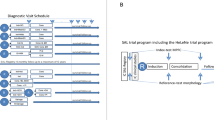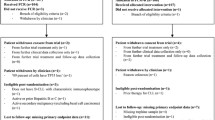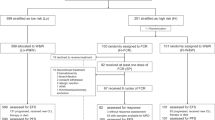Abstract
The open-label, prospective, observational study aimed to evaluate whether the addition of maintenance rituximab (MR) improved progression-free survival (PFS) and overall survival (OS), after fludarabine, cyclophosphamide, and rituximab (FCR) for cytogenetic risk-tailored elderly patients with chronic lymphocytic leukemia (CLL). Enrolled 201 patients (ages 65–84 years) who received FCR and gained an overall response. One hundred and four of 201 patients were in the observation (OBS) arm while 97/201 patients continued to receive MR therapy. After FCR, no more benefits were provided by MR versus OBS in cytogenetic better intermediate-risk cohort. PFS at 10 years reached 68.6 versus 58.1 % (P > 0.05). Ten-year OS was 81.8 versus 74.6 % (P > 0.05). However, the improvement of PFS and OS were as dramatic as the improvements of being MR treating versus OBS mainly in the poor-risk cohort. PFS at 10 years reached 57.1 versus 22.7 % (P < 0.01), and 10-year OS was 71.2 versus 41.7 % (P < 0.01). Compared with OBS, no severe hematologic adverse events (AEs) (Grades 3–4) appeared in patients with MR; only some mild non-hematologic AEs incurred (nausea–vomiting 0.96 %, allergy 1.9 % and infection 1.9 %) during the maintenance treatment. The study showed that MR improved 10-year RFS and OS for cytogenetic poor-risk patients with CLL.



Similar content being viewed by others
References
Ricci F, Tedeschi A, Morra E, et al. Fludarabine in the treatment of chronic lymphocytic leukemia: a review. Ther Clin Risk Manag. 2009;5:187–207.
Bryan J, Borthakur G. Role of rituximab in first-line treatment of chronic lymphocytic leukemia. Ther Clin Risk Manag. 2010;7:1–11.
Cao TM, Coutre SE. Management of advanced chronic lymphocytic leukemia. Curr Hematol Rep. 2003;2:65–72.
Jaglowski SM, Alinari L, Lapalombella R, et al. The clinical application of monoclonal antibodies in chronic lymphocytic leukemia. Blood. 2010;116:3705–14.
Keating MJ, O’Brien S, Albitar M, et al. Early results of a chemoimmunotherapy regimen of fludarabine, cyclophosphamide, and rituximab as initial therapy for chronic lymphocytic leukemia. J Clin Oncol. 2005;23:4079–88.
Tam CS, O’Brien S, Wierda W, et al. Long-term results of the fludarabine, cyclophosphamide, and rituximab regimen as initial therapy of chronic lymphocytic leukemia. Blood. 2008;112:975–80.
Smolej L. Therapy of elderly/comorbid patients with chronic lymphocytic leukemia. Curr Pharm Des. 2012;18:3399–405.
Riches JC, Ramsay AG, Gribben JG. Chronic lymphocytic leukemia: an update on biology and treatment. Curr Oncol Rep. 2011;13:379–85.
Ghielmini M, Schmitz SF, Cogliatti SB, et al. Prolonged treatment with rituximab in patients with follicular lymphoma significantly increases event-free survival and response duration compared with the standard weekly × 4 schedule. Blood. 2004;103:4416–23.
Hainsworth JD, Lichty S, Shaffer DW, et al. Maximizing therapeutic benefit of rituximab maintenance therapy versus re-treatment at progression in patients with indolent non-Hodgkin’s lymphoma—a randomized phase II trial of the Minnie Pearl Cancer Research Network. J Clin Oncol. 2005;23:1088–95.
Del Poeta G, Del Principe MI, Buccisano F, et al. Consolidation and maintenance immunotherapy with rituximab improve clinical outcome in patients with B-cell chronic lymphocytic leukemia. Cancer. 2008;112:119–28.
Robak T. Maintenance in CLL. Blood. 2013;122:3854–5.
Siegel R, DeSantis C, Virgo K, et al. Cancer treatment and survivorship statistics, 2012. CA Cancer J Clin. 2012;62:220–41.
Huang BT, Zeng QC, Yu J, et al. How to determine post-RCHOP therapy for risk-tailored adult patients with diffuse large B-cell lymphoma, addition of maintenance rituximab or observation: multicenter experience. J Cancer Res Clin Oncol. 2012;138:125–32.
Cheson BD, Bennett JM, Grever M, et al. National Cancer Institute Sponsored Working Group Guidelines for chronic lymphocytic leukemia: revised guidelines for diagnosis and treatment. Blood. 1996;29:4990–7.
Döhner H, Stilgenbauer S, Benner A, et al. Genomic aberrations and survival in chronic lymphocytic leukemia. N Engl J Med. 2000;343:1910–6.
Hallek M, Cheson BD, Catovsky D, et al. Guidelines for the diagnosis and treatment of chronic lymphocytic leukemia: a report from the International Workshop on Chronic Lymphocytic Leukemia updating the National Cancer Institute-Working Group 1996 guidelines. Blood. 2008;111:5446–56.
Yee KW, O’Brien SM, Giles FJ. An update on the management of chronic lymphocytic leukaemia. Expert Opin Pharmacother. 2004;5:1535–54.
Huang BT, Tan Y, Zhao WH, et al. How to determine bortezomib-based regimen for elderly patients with multiple myeloma: PAD versus CBd, an observational study. J Cancer Res Clin Oncol. 2014;140:303–9.
Hainsworth JD, Litchy S, Barton JH, et al. Single-agent rituximab as first-line and maintenance treatment for patients with chronic lymphocytic leukemia or small lymphocytic lymphoma: a phase II trial of the Minnie Pearl Cancer Research Network. J Clin Oncol. 2003;21:1746–51.
Huang BT, Zhao WH, Zeng QC, Li BS, Chen RL. Standard intensive chemotherapy is less effective and far more toxic than attenuated induction and post-induction regimen in elderly patients with acute myeloid leukemia. Med Oncol. 2014;31:962.
Acknowledgments
We would like to thank all the patients and clinicians from the participating sites. This work was supported by Grants from the Natural Science Foundation of Inner Mongolia (2013MS1157) and Inner Mongolia Autonomous Region Health and Family Planning Health Research Projects (201302059). All authors discussed the results and commented on the manuscript.
Conflict of interest
I would like to declare on behalf of my co-authors that this work is original research that has not been published previously and is not under consideration for publication elsewhere, either in part of in whole. All the authors listed have approved the manuscript that is enclosed.
Author information
Authors and Affiliations
Corresponding author
Additional information
Bin-Tao Huang and Qing-Chun Zeng have equally contributed to this work.
Rights and permissions
About this article
Cite this article
Huang, BT., Zeng, QC., Zhao, WH. et al. How to determine post-FCR therapy for cytogenetic risk-tailored elderly patients with chronic lymphocytic leukemia, maintenance rituximab or observation. Med Oncol 31, 104 (2014). https://doi.org/10.1007/s12032-014-0104-7
Received:
Accepted:
Published:
DOI: https://doi.org/10.1007/s12032-014-0104-7




